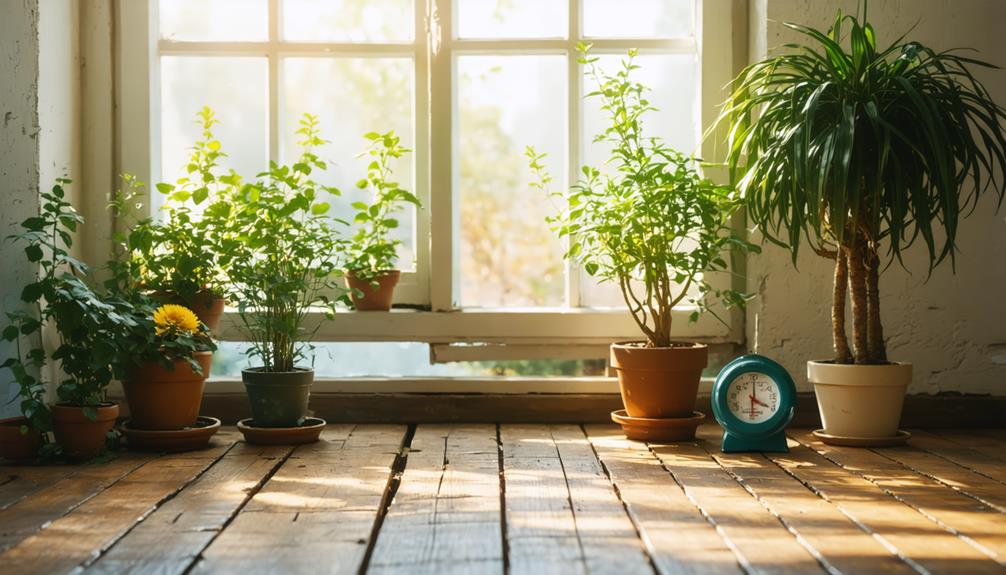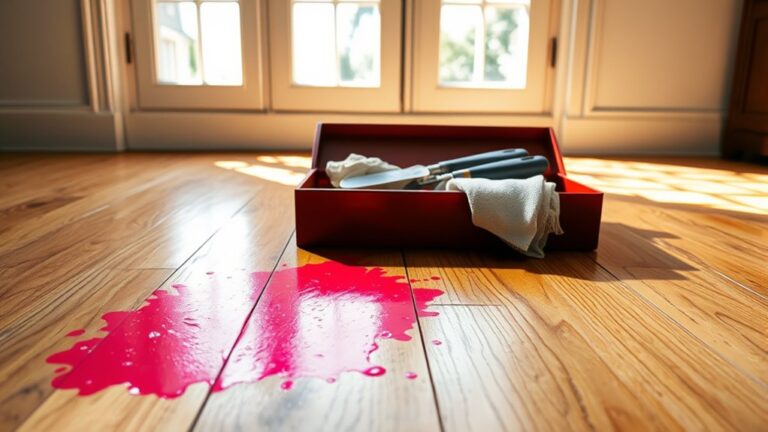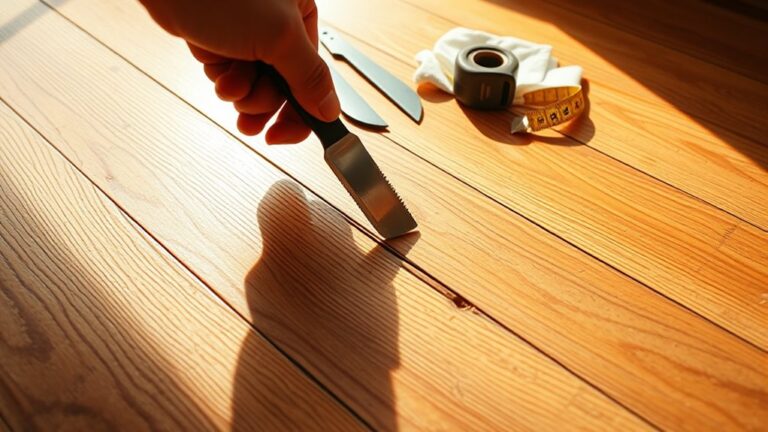To manage hardwood floor expansion during summer heat and humidity, you need to maintain indoor humidity levels between 35% and 55%. Use dehumidifiers to reduce moisture and consider monitoring conditions with a hygrometer. It's essential to keep blinds closed on hot days to limit direct sunlight, which can aggravate expansion issues. Regularly clean and vacuum your floors to prevent dirt buildup. If you notice gaps or buckling, address them promptly to avoid extensive damage. Taking these proactive steps can safeguard your floors, but there's more you can do to guarantee long-term integrity and protection against seasonal changes.
Understanding Hardwood Floor Expansion
When it comes to hardwood pavimento expansion, understanding the underlying factors is essential. Hardwood flooring responds considerably to variations in temperature and humidity, primarily due to its organic nature. When humidity levels rise, the wood absorbs moisture from the air, causing it to expand. This increase in moisture content directly influences the volume of the wood, leading to potential issues as the planks press against each other.
You should be aware that maintaining indoor humidity between 35% and 55% is vital for mitigating expansion. If humidity levels exceed this range, especially during the summer months, your hardwood floors may experience considerable expansion. This can result in flexing, warping, or cupping, which not only affects the aesthetic appeal of your flooring but may also lead to expensive repairs.
Seasonal fluctuations in humidity can drastically impact the physical properties of wood, making it essential to monitor and control indoor conditions. Proper acclimation of hardwood flooring before installation can also be beneficial. Allowing the wood to adjust to the home's climate can minimize the risks of expansion during warmer months.
Effects of Humidity and Temperature
Humidity and temperature play essential roles in the expansion of hardwood floors. When humidity levels rise, the wood absorbs moisture, causing it to swell and potentially buckle. Additionally, as temperatures increase, the combination of warm air and high humidity can exacerbate these issues, necessitating careful monitoring and management to maintain floor integrity.
Humidity's Impact on Expansion
High humidity levels during the summer can wreak havoc on hardwood floors, causing them to absorb excess moisture from the air. When humidity levels exceed the ideal range of 35%-55%, your hardwood floors will begin to expand as the wood swells. This moisture absorption can lead to significant wood movement, which may result in severe damage. As the wood expands and contracts, you might notice symptoms like cupping, where the edges of the planks rise above the center, and squeaky floorboards that indicate instability.
It's essential to monitor the moisture content in your hardwood floors using a wood moisture meter, as this can help you assess the impact of humidity on your flooring. High humidity, combined with warm temperatures, can exacerbate the problem, causing planks to press against each other, leading to warping and buckling. To mitigate these issues, maintain a consistent humidity level in your home. Utilizing dehumidifiers in areas prone to high humidity can help protect your hardwood floors, ensuring they remain stable and intact throughout the summer heat. Taking these steps will help preserve the beauty and integrity of your floors for years to come.
Temperature Fluctuations and Effects
Excess moisture isn't the only factor affecting hardwood floors during the summer months; temperature fluctuations also play a significant role. When temperatures rise, the air can hold more moisture, leading to increased humidity in your home. This combination of extreme heat and humidity causes hardwood floors to absorb excess moisture, resulting in floor expansion.
As the temperature soars, the planks can press tightly against each other, leading to flexing and potential issues like warping and squeaky floorboards. You might notice that your hardwood floors become more challenging to maintain, with symptoms of damage becoming apparent.
To mitigate these effects, it's essential to maintain indoor humidity levels between 35%-55%. This range helps minimize the impact of temperature fluctuations on your hardwood floors and keeps moisture levels in check. If humidity levels exceed this range, you risk experiencing cracking and loose boards that may require costly professional repairs. By staying vigilant about both temperature and humidity, you can protect your investment and keep your hardwood floors looking their best throughout the summer.
Essential Humidity Control Strategies
Controlling moisture levels in your home is essential for protecting hardwood floors from summer heat. Maintaining indoor humidity levels between 35%-55% is vital; otherwise, excessive wood expansion can occur, leading to buckling or cupping of your hardwood floors. To effectively manage moisture, consider utilizing dehumidifiers in areas prone to high humidity. These devices can greatly reduce moisture levels in the air, providing a protective barrier against potential damage.
Additionally, it's wise to regularly monitor humidity levels with a hygrometer. This tool allows you to take timely action if humidity levels exceed the recommended range, helping preserve the integrity of your hardwood flooring. During dryer seasons, installing humidifiers can also be beneficial, as they maintain ideal moisture levels and prevent wood from contracting, which can create unsightly gaps between floorboards.
Implementing effective temperature control measures is equally important. Setting your air conditioning below 75 degrees Fahrenheit not only cools your home but also aids in managing humidity levels. This dual approach reduces the risk of floor expansion due to excessive heat and moisture.
Seasonal Maintenance Tips
To keep your hardwood floors in top condition during the summer months, it is crucial to implement a seasonal maintenance routine. First, aim to maintain indoor humidity levels between 35%-55%. This range prevents excessive wood expansion and potential buckling of your hardwood floors. Regularly monitor these humidity levels and utilize dehumidifiers in high humidity areas to mitigate moisture-related floor damage.
In addition to humidity control, incorporate a seasonal deep cleaning routine. Remove dirt and debris that can trap moisture and damage the wood. Vacuum or sweep regularly and use a damp mop with a hardwood floor cleaner designed specifically for your flooring type.
To further protect your floors, keep blinds or drapes closed during hot days. This simple action reduces direct sunlight exposure, which can help prevent UV fading and temperature-related expansion of the wood.
Identifying and Managing Gaps
You might notice seasonal gaps in your hardwood floors, especially during winter when cold weather causes contraction. If these gaps persist into the summer, it could signal excessive moisture levels during installation or other underlying issues that require your attention. By managing indoor humidity levels and monitoring the environment, you can effectively minimize the risk of developing gaps in your flooring.
Seasonal Gaps Overview
Seasonal gaps in hardwood floors can be a common issue, particularly during the summer months when humidity levels rise. While these gaps are often associated with winter contraction, they can also manifest in summer due to improper acclimation or excessive moisture during installation. It's essential to maintain indoor humidity levels between 35% and 55% year-round to minimize these seasonal gaps.
Monitoring and controlling humidity is imperative; using dehumidifiers in the summer can help manage excess moisture, while humidifiers are beneficial in the winter. If gaps persist by the end of summer, it's a clear indication that further inspection is needed. You should consider factors like new building materials or improper installation techniques that may contribute to abnormal gaps.
To effectively manage seasonal gaps, repair them during milder months. Using color-matched filler can camouflage these gaps, ensuring a seamless appearance. Proper acclimation of flooring materials before installation is crucial, as it helps mitigate the risk of expansion and contraction, keeping your hardwood floors looking their best. By staying proactive, you can maintain the integrity and aesthetic of your floors throughout the changing seasons.
Managing Excessive Moisture
Managing excessive moisture is essential for maintaining hardwood floors, especially during the humid summer months. High humidity levels can lead to floor expansion, which may create gaps when conditions dry out, particularly in air-conditioned spaces. To combat this, monitor your indoor humidity levels and aim to keep them between 35% and 55%. This range helps prevent excessive moisture from affecting the integrity of your hardwood floors.
If you notice abnormal gaps that don't close by summer's end, it may indicate underlying moisture issues or installation problems. Utilizing a moisture meter will provide accurate readings of the moisture levels in both your flooring and the surrounding environment. This can guide you in making necessary adjustments to avoid further damage.
Addressing gaps promptly is vital. Using appropriate fillers can help, but if the gaps persist or worsen, seeking professional repairs may be necessary. Neglecting these gaps can lead to more extensive damage and costly fixes, so it's in your best interest to act swiftly. By actively managing moisture levels and addressing gaps, you can enjoy your hardwood floors for years to come.
Professional Solutions and Repairs
Dealing with summer heat can lead to significant challenges for hardwood floors, making professional solutions and repairs vital. A professional assessment of your hardwood flooring is important to understanding the extent of any damage caused by summer expansion. Flooring specialists can identify issues like buckling or cupping, recommending tailored repair methods that restore both aesthetics and functionality.
Here's a look at common professional solutions:
| Problema | Recommended Solution |
|---|---|
| Significant Buckling | Refinishing or sanding affected areas |
| Cupping | Sanding to level the surface |
| Gaps After Summer Changes | Color-matched filler application |
| General Maintenance | Regular evaluations and repairs |
In cases of significant buckling, refinishing may be necessary to bring back the original look of your floors. For cupping, sanding down the surface can effectively even it out. If gaps remain post-summer, using color-matched filler can seamlessly blend the repairs, maintaining your floor's visual appeal.
Regular maintenance from professionals not only addresses immediate concerns but also prevents long-term damage from heat and humidity. By consulting with flooring specialists, you can guarantee that any repairs align with your flooring's material properties, ultimately extending its lifespan. Don't wait until minor issues become major problems; proactive care is key to preserving the beauty and integrity of your hardwood floors.
Domande frequenti
How to Stop Hardwood Floor Buckling in Summer?
To stop hardwood floor buckling in summer, focus on humidity control and temperature regulation. Guarantee proper installation with moisture barriers to protect flooring materials from excessive moisture. Seasonal maintenance is essential; use dehumidifiers to maintain indoor humidity between 35%-55%. Avoid direct sunlight exposure by utilizing blinds or drapes. Regularly check your HVAC system to guarantee it effectively manages both temperature and humidity, preventing conditions that could lead to buckling of your floors.
Do Floors Expand in the Summer?
Imagine you've just installed beautiful hardwood floors. As summer rolls in, you notice them expanding due to humidity effects. Yes, floors expand in the summer! Seasonal changes, like increased temperature fluctuations, cause wood to absorb moisture. To mitigate this, consider installation techniques that allow for movement, and maintain indoor humidity levels between 35% and 55%. Regular maintenance tips, such as using dehumidifiers, can help protect your floor materials from potential damage.
Do Floors Swell in Summer?
Yes, floors can swell in summer due to increased floor moisture and humidity levels. As temperature fluctuations occur, wood species absorb moisture, leading to expansion. To mitigate this, make certain you've installed adequate expansion gaps during installation. Regular seasonal maintenance, like monitoring humidity levels and using dehumidifiers, can help prevent excessive swelling. Staying proactive can extend your floors' lifespan and maintain their appearance, allowing you to enjoy your space without worry.
Does Flooring Expand in Heat?
Yes, flooring does expand in heat due to temperature effects and humidity levels. Different flooring materials react uniquely, so understanding their properties is essential. During installation, use techniques that accommodate for these seasonal changes, ensuring proper spacing between planks. To maintain your floors, monitor humidity levels between 35%-55% and consider using a dehumidifier if necessary. Regular maintenance tips can help manage expansion and contraction, allowing you to enjoy your flooring without worry.




